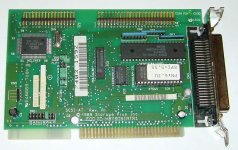SomeGuy
Veteran Member
Some people here might be interested in these, I stumbled across a seller selling a bunch of low-end AT ISA SCSI cards for a decent price. But what caught my eye is that unlike most AT ISA SCSI cards, this actually has 8-bit electronics. After obtaining and testing one of these, I confirmed my suspicion: This will work on an 8-bit PC/XT or compatibles equipped with an NEC V20 CPU.

At present the seller has them listed for US $17.50 each with free shipping, and the page says there are "more than 10".
https://www.ebay.com/itm/STORAGE-PL...A-SCSi-HOST-CONTROLLER-BOARD-FCC/232620890451
There is not a lot of information about this particular card, so I am posting my test results here:
This card is a Sumo Systems / Storage Plus, Inc "SCSI-AT". Reportedly this model was later renamed to "SPI 200".
This appears to be a fairly low-end Japanese SCSI card.
It uses an 8-bit NCR53C80 SCSI chip, and an NCL2020 Floppy Disk Controller.
Jumper settings can be found here: http://arvutimuuseum.ee/th99/c/S-T/20203.htm . For PC/XT operation you must set the IRQ to 3, 4, or 5.
I tested this on several XT clone motherboards as well as an IBM 5150 motherboard. If the motherboard is equipped with an 8088, the system probe for SCSI devices, but will freeze up as it tries to boot the hard drive.
If the system is equipped with an NEC V20, the system will boot from the hard drive, and appears to work normally. This indicates that the BIOS uses some 186 or V20 specific code. (Perhaps someone could hack the BIOS to enable 8088 operation?)
The caveat is that the high density floppy controller appears not to work at all in a PC/XT class system. However, there is a jumper to disable the FDC letting you use another card. I would have expected it to operate in low-density mode like some IDE/FDC cards, but it acts like the hardware can not be found at all.
Unsurprisingly, there appears to be no floppy support in the card's BIOS, and no way to select drive type without AT CMOS settings. I tried ImageDisk, that bypasses BIOS, and it could not talk to the FDC either. 2M-XBIOS also did not work.
There are SCSI DOS drivers for this card, but those are not needed to operate a normal hard drive. I did try attaching a SCSI ZIP drive, however it did not work with it. (It did show up in the probe list at boot)
I tested the speed with Coretest. It is no speed demon, but it is not bad.
IBM 5150 motherboard with NEC v20 and a Quantum Lightning 540S, Coretest 2.4 reports 385KB/Sec
For comparison, a Lo-tech ISA CompactFlash Adapter in a 4.77mhz 8088 machine (CDP 1600) reports: 175KB/Sec
Attaching drivers, and a dump of the BIOS chip.
View attachment Storage Plus SCSI-AT R1 BIOS.zip
View attachment scsi-at.zip

At present the seller has them listed for US $17.50 each with free shipping, and the page says there are "more than 10".
https://www.ebay.com/itm/STORAGE-PL...A-SCSi-HOST-CONTROLLER-BOARD-FCC/232620890451
There is not a lot of information about this particular card, so I am posting my test results here:
This card is a Sumo Systems / Storage Plus, Inc "SCSI-AT". Reportedly this model was later renamed to "SPI 200".
This appears to be a fairly low-end Japanese SCSI card.
It uses an 8-bit NCR53C80 SCSI chip, and an NCL2020 Floppy Disk Controller.
Jumper settings can be found here: http://arvutimuuseum.ee/th99/c/S-T/20203.htm . For PC/XT operation you must set the IRQ to 3, 4, or 5.
I tested this on several XT clone motherboards as well as an IBM 5150 motherboard. If the motherboard is equipped with an 8088, the system probe for SCSI devices, but will freeze up as it tries to boot the hard drive.
If the system is equipped with an NEC V20, the system will boot from the hard drive, and appears to work normally. This indicates that the BIOS uses some 186 or V20 specific code. (Perhaps someone could hack the BIOS to enable 8088 operation?)
The caveat is that the high density floppy controller appears not to work at all in a PC/XT class system. However, there is a jumper to disable the FDC letting you use another card. I would have expected it to operate in low-density mode like some IDE/FDC cards, but it acts like the hardware can not be found at all.
Unsurprisingly, there appears to be no floppy support in the card's BIOS, and no way to select drive type without AT CMOS settings. I tried ImageDisk, that bypasses BIOS, and it could not talk to the FDC either. 2M-XBIOS also did not work.
There are SCSI DOS drivers for this card, but those are not needed to operate a normal hard drive. I did try attaching a SCSI ZIP drive, however it did not work with it. (It did show up in the probe list at boot)
I tested the speed with Coretest. It is no speed demon, but it is not bad.
IBM 5150 motherboard with NEC v20 and a Quantum Lightning 540S, Coretest 2.4 reports 385KB/Sec
For comparison, a Lo-tech ISA CompactFlash Adapter in a 4.77mhz 8088 machine (CDP 1600) reports: 175KB/Sec
Attaching drivers, and a dump of the BIOS chip.
View attachment Storage Plus SCSI-AT R1 BIOS.zip
View attachment scsi-at.zip
